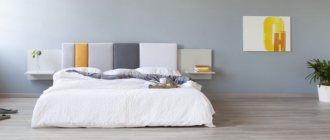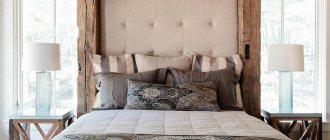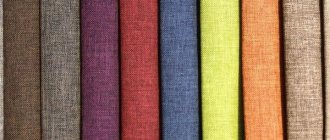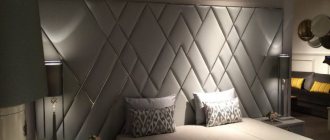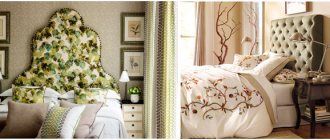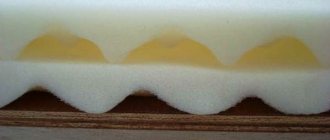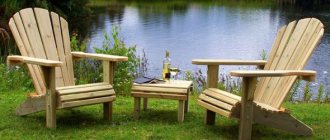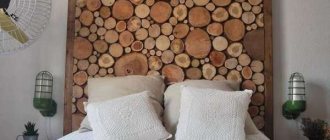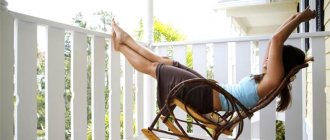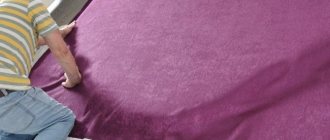Carpet or tapestry
Carpets never go out of style, but what is truly valued today are vintage and hand-woven items with unusual patterns. You can attach the carpet directly to the wall or to a wooden strip. The second method will allow you to easily remove the canvas for cleaning.
Patterned rugs, tapestries, appliqués and patchwork items will replace the headboard and give the bedroom interior a bright, individual character.
Preparation of material and tools
The original headboard serves as the final stage of any sleeping place. With it the bed looks impressive and beautiful, it gives the bedroom a unique style and originality. How to make a headboard with your own hands is a question for those who want to create new or update old furniture themselves. This work requires a certain time, a special set of devices, materials and diagrams, drawings for making a bed with your own hands.
For this you will need materials:
- sheets of plywood of medium thickness - it is advisable to take the furniture version;
- foam rubber, batting necessary for a soft headboard for a bed with your own hands;
- nails – preferably 1.5 inches thick;
- decorative fabric - you need to buy it in furniture stores. The cut size is selected based on the area of the product, but do not forget about the margin for the hem;
- a set of bolts and hinges with which the headboard is attached to the wall or bed frame;
- required number of buttons, snaps. It is better to go with metal ones, since plastic buttons have impractical legs. You will need regular buttons with holes to secure them on the wrong side;
- needles are thick and durable;
- threads - nylon threads are suitable, they are quite durable.
Tools you will need:
- a jigsaw is a necessary tool when you need to make a figured headboard with your own hands;
- furniture stapler - it’s safer to take a metal one, with a device for staples of different sizes;
- drill and drills - without them it is impossible to make the necessary holes;
- construction sawhorses - useful for dismantling large sheets of plywood;
- knife with a wide blade and scissors;
- an ordinary hammer and screwdriver;
- a set of sewing accessories - necessary when decorating.
Bamboo
The unusual back will be made from bamboo trunks coated with varnish or paint. You should not adhere to strict symmetry when forming a composition: slight disorder will add naturalness to it. Bamboo is a rather active element of the interior, so it is recommended to use it in laconic interiors so as not to overload the decor.
Instead of whole trunks, you can use their halves, as well as natural wallpaper made from bamboo fiber.
Popular options for finishing the wall above the bed in 2022
There are many options for designing the wall above the bed in the bedroom. For this, both classic solutions and modern finishing options are used. The selected material creates the appropriate mood in the room and supports a certain style.
Laminate
A classic floor covering that can get an original feel as wall decor. The material is durable, has a dense structure, and is easy to care for.
A characteristic advantage of this choice is a wide range of shades and textures that imitate various materials.
Laminate flooring is suitable for use in the bedroom, but care should be taken when placing it in small spaces .
If the material is attached to the sheathing, the space immediately loses volume, which limits its functionality.
Tile
A modern solution for forming an accent wall above the bed. With its help, it is possible to decorate with mosaics, reproduce the structure of stone, etc.
You should pay attention to gypsum tiles: they will fit well into the interior, imitating fashionable brickwork.
Mirror tiles located at the head of the bed also look interesting.
Wall panels
An advantageous finishing option used for indoor and outdoor decoration. They are mounted on any surface, regardless of its curvature and appearance.
Installing the panels makes it possible to avoid the lengthy process of plastering and putty, but you will have to form a sheathing from wooden blocks or metal profiles. This design will reliably hide all existing irregularities.
Solid wall panels are available in the form of sheets, slats or slabs.
Soft wall panels are textured and are made from materials such as:
- fabric - velvet or velor;
- genuine leather is one of the most expensive types of material, more suitable for business premises such as an office;
- faux leather is an exquisite material that is similar to natural leather, but costs less and is easy to care for.
Photo wallpaper
They are wallpaper on which a thematic image is applied using large-format printers.
This is a good option for decorating a room, since a large assortment of photo wallpapers helps you choose the right material for any design.
For example, photo wallpapers with images of nature, sea or sky are considered popular - their calming and relaxing effect is beneficial in the bedroom.
3D wallpaper
These are canvases on which a three-dimensional image is applied, which creates a feeling of the presence of the picture.
This technique allows you to visually separate the boundaries of space, and the decor in the room looks interesting and expensive. It allows you to recreate a thematic atmosphere without much expense.
3D wallpaper is easy to maintain and safe for human health, is fire resistant and does not lose color over time.
Brick or stone wall
A smooth, cold wall quickly turns into a cozy and warm one if it is decorated with natural stone.
Rough surfaces add dynamism and monumentality to the interior, bringing notes of living nature into the room.
The most popular brick colors are gray, noble beige, dark chocolate, which are considered universal options for interior decoration.
The main advantages of brick walls are:
- stylish look - the brick on the walls looks modern and fresh, which allows you to maintain a laconic design and not sacrifice useful space;
- great possibilities for painting - paint will help the brick wall fit well with the interior of the bedroom thanks to the extensive color palette, if the original color of the brick turned out to be unsuitable;
- durability - brickwork does not wear out and becomes more and more authentic over the years, which gives the room a natural charm;
- strength - brick is durable and wear-resistant. Even random chips on it will look natural and beautiful, unlike crumbling paint or torn wallpaper;
- safety - this is a natural material that is safe for human health and does not cause allergies.
Natural stone used for bedroom decor is characterized by the following advantages:
- unique natural texture;
- creating a sense of naturalness;
- good sound insulation properties;
- durability.
The use of masonry makes it possible to achieve peace and comfort and create a sense of security.
False window
Imitating a window in the bedroom is not only a decoration, but also an opportunity to completely change the space, covering up some of its shortcomings.
A false window is a realistic imitation of a window on the wall, which is created using drawings or a fake window opening using mirrors, glass, etc. Such windows can expand the space and create the illusion of being in another place.
Since false windows are not equipped with through slits, they will not let in sunlight. To recreate the plausibility of lighting, you should choose models that have built-in lighting.
Cork
This is a natural material that is used for wall decoration. The final result is not only an aesthetically pleasing design element, but also a functional structure that is characterized by thermal and sound insulation properties, durability and resistance to mold and mildew.
Using natural and eco-friendly materials in the bedroom is a big plus in any case. At the same time, owners also receive a soft and natural color palette and originality, which can be interestingly played out in the interior.
Decorative plaster
A material that can become one of the most noticeable accents in the design of a room. It has several varieties that imitate natural surfaces, which allows you to make the interior unique and varied.
When working with textures, you should definitely pay attention to the simulated plaster. It can imitate various surfaces: from crumpled silk to rough concrete, which will help to significantly diversify your interior design.
Optimized by JPEGmini 3.9.2.5L Internal 0x19e40d29
Architectural concrete
This is a durable, flexible and easy-to-work material used in situations where ordinary concrete is not enough to complete the task.
The art material is created from a mixture of sand and cement, and pigments are added to its composition to obtain the desired color.
This is a durable and resistant material that is immune to sunlight and has minimal hygroscopicity. Its plasticity opens up scope for the implementation of various original design ideas.
Ceiling to wall
This is an original solution that has become very popular recently in designer interiors. This option for designing a space is an arch or semi-arch - a structure that combines vertical and horizontal surfaces in the room.
The correct selection of panel orientation (horizontal and vertical) provides a feeling of proportional room, which visually expands or stretches upward. To decorate residential premises and, in particular, bedrooms, slatted structures are usually used.
Pillows
Decorative pillows mounted on the wall look cozy and are useful for those who like to read before bed or sit in bed with a laptop. The best option is to use products with removable pillowcases so that they can be removed and washed at any time. Pillows are attached to hooks or railings.
Fixing the decor “Crown” and others
Various decorative elements for decorating furniture are popular. Curtains and canopies are often used. How to attach a curtain frame over a bed:
- “Crown”: made in the shape of a circle, semicircle or square, equipped with hooks or slats for hanging a curtain. Mounts to the wall above the headboard or to the ceiling in the center of the bed.
- “Racks”: the frame starts from the legs. Often it is connected on top in the form of a square, so you can hide the bed completely or just its corners.
- A “crossbar” made of a pipe attached to the wall. A canopy is thrown over it.
- “Arc”: the frame is mounted to the wall above the headboard, the fabric is attached to it with clips or clothespins.
- “Cords”: hooks are attached to the ceiling opposite each corner, and slightly sagging cords are tied to them. A curtain is hung over them.
- “Independent circuit”: a frame is welded from pipes or assembled from other materials and mounted above the berth. In appearance it follows the shape and size of the bed.
Natural wood
The enduring trend of modern fashion is environmental friendliness, which means wood textures and decor made from natural materials will always be relevant. Instead of a headboard, a shield decorated with wood cuts, new or barn boards, or processed slab with uneven edges is suitable. The last option is quite expensive, but it instantly gives the atmosphere nobility and originality.
How to sew a cover for the head of a bed.
You will need: • Cotton upholstery fabric 100 cm long and 137 cm wide • Cotton fabric for lining 120 cm long and 137 cm wide • Sintepon or batting 94 x 97 cm • Cord for piping - 2 m • Threads to match • Pins
1. This cover is designed for a headboard measuring 91 x 94 cm. From upholstery fabric, cut out a rectangle 94 x 52 cm for the front part of the cover and a rectangle 94 x 48 cm for the back part, as well as 8 strips 30 x 9 cm for the ties. From the lining fabric, cut out one rectangle 94 x 97 cm and 2 rectangles 67 x 33 cm for the side flaps. Make 2 m of piping: cut out the bias tape from the lining fabric and sew a cord into the middle, stitching along the front side as close to the cord as possible.
Pallet
Pallets are a consumable material used for transporting and storing goods. But in modern interiors they have firmly established themselves as fashionable decor and the basis for furniture.
The headboard can be either the pallets themselves, mounted on a bed or wall, or boards connected to each other. Pallets must be treated in advance: washed, sanded and coated with a protective composition: oil, paint or stain.
Fastening the upholstery
Once you have sewn on all the buttons, it is time to secure the fabric around the perimeter. To do this, place the headboard on the floor with the front facing down. You have already secured the upper part, but it won’t hurt to go through it with a stapler again. To make the corners neat, straighten and stretch the fabric on the sides and fold it horizontally so that a horizontal fold-seam is formed. Secure with a stapler. Continue all the way around the headboard. Don't try too hard: everything should be neat from the front, but the back doesn't have to be perfect.
Before securing the bottom section, lift the headboard and trim off the excess fabric in front of the legs, leaving a slight allowance. Fold the fabric over, stretch and secure at the back, just as in other cases.
Drawing
A replacement for the headboard can be an unusual coloring of the wall behind the bed. You can use the gradient technique, stencils, resort to partial coloring, or apply a simple geometric pattern. When you get tired of the headboard, you can simply repaint the wall or wallpaper it.
Perforated board
Perforated boards are often used as a storage system, and if previously they could be found in garages, today they are a fashionable detail in designer apartments. In the bedroom it is recommended to use a board made of MDF or plywood: it can be painted in any suitable color, equipped with shelves, hooks and rails.
The advantage of perforated board is its versatility. You can change not only the decor, but also its location.
To prevent small sawdust from falling into the bed, the edges must be sanded and varnished.
If you implement any of these non-standard ideas, the headboard will become the main decoration of the bedroom and give it originality and comfort.
DIY soft headboard with cushions, tile imitation
Materials and tools:
a large rectangular sheet of plywood for the base (in the project 150 cm by 75 cm); small plywood squares (for this project 18 pieces measuring 25 by 25 cm were needed); a piece of fabric; synthetic winterizer; furniture stapler; scissors; glue.
Progress
Prepare the plywood pieces. In large construction supermarkets, you can ask them to cut the plywood into pieces of the required size. Cut the piece of fabric into 18 squares (in your case the number may be different). The squares should have a margin of 5-10 cm on each side.
Place the plywood squares in the middle of the fabric.
Using a furniture stapler, attach the edges of one side. Be careful that the staple does not pierce all the way through the plywood and fabric. You can insert the staples at a slight angle.
Make a fold in the corner, stretch the fabric well and secure the corner with staples.
So, you have secured one side and two corners, making something like a “pocket”. Now, adding a staple on each side, fill the space between the plywood and the fabric with batting or padding polyester. Try to ensure that there is practically no filler closer to the edges, and there is a plump “slide” in the middle.
Having filled the square with padding polyester and secured the sides, secure the last remaining side and corners with staples in the same way.
Do the same for the rest of the squares. If the fabric has a pattern, try to keep it the same on all parts. You can also use different fabrics to create a multi-colored mosaic composition.
When all the squares are ready, place them on a large sheet of plywood and glue them with universal glue. Make sure the pattern is positioned correctly. Try not to have a large distance between the squares; the joints should be barely noticeable.
